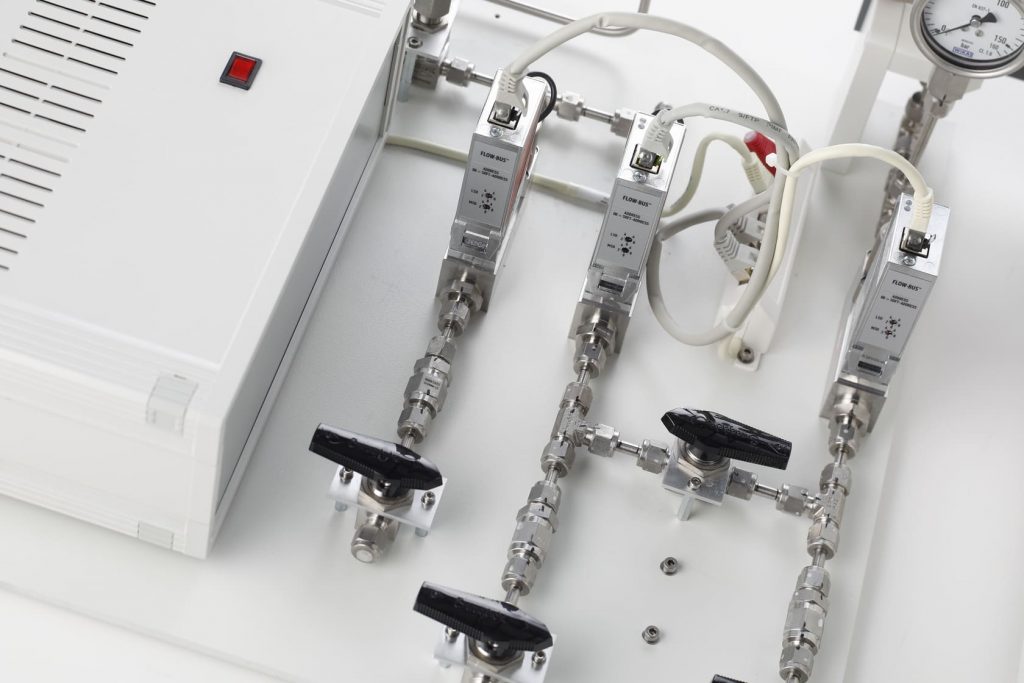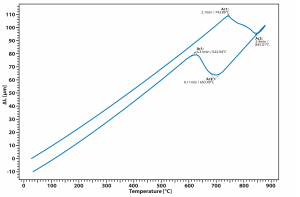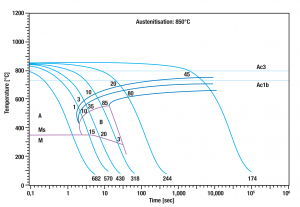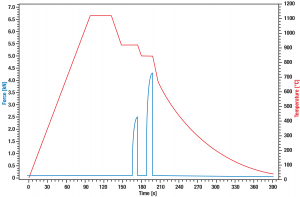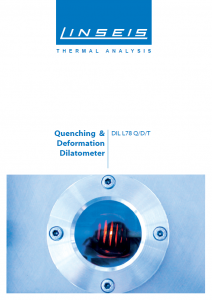DIL L78 QDT / RITA
Quenching Dilatometer and Deformation Dilatometer – TTT- CCT- CHT – Diagram
Description
On point
The Quenching and Deformation Dilatometer L78 QDT is especially suitable for the determination of TTT, CHT and CCT diagrams. The special induction furnace enables heating and cooling speeds in excess of 4000 K/s. The system complies with ASTM A1033.
The method:
This practice is based upon the principle that, during heating and cooling of steels, dimensional changes occur as a result of both thermal expansions associated with temperature change and phase transformation. In this practice, sensitive high-speed quenching dilatometer equipment is used to detect and measure the changes in dimension that occur as functions of both time and temperature during defined thermal cycles.
Main advantaged of the DIL L78 RITA QDT Quenching Dilatometer and Deformation Dilatometer:
- The instrument can perform measurements under vacuum, inert, oxidized, reduced atmospheres from -150°C (low temperature option) up to 1600°C in one run.
- The unique heating and cooling arrangement enable very fast controlled heat up and cool down speeds of up to 4000 K/s.
- • With the optional susceptor non-metallic samples can be analyzed.
- This special Quenching dilatometer is especially designed for the determination of continuous cooling / heat up CHT, CCT and isotherm TTT- diagrams.
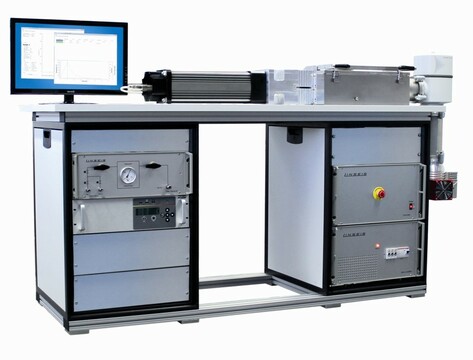
Quenching Dilatometer and Deformation Dilatometer DIL L78 QDT
The resulting data are converted to discrete values of strain for specific values of time and temperature during the thermal cycle. Strain as a function of time or temperature, or both, can then be used to determine the beginning and completion of one or more phase transformations.
All critical parameters such as heat up and cool down speed, gas control and safety features are software controlled. The professional 32-bit software Linseis TA-WIN operates exclusively under the Microsoft© operation system.
All routine (creation of CHT/CCT/TTT diagrams) and demanding applications are solved by the unique Software package which comes with the instrument. Certainly export functions in ASCII-format as well as graphic output is possible.
During heating, steel phase transformation of the crystallographic transformation from ferrite, pearlite, bainite, martensite or combinations of these constituents to austenite take place. During cooling, the crystallographic transformations from austenite to ferrite, pearlite, bainite, or martensite or a combination thereof occur.
The LINSEIS L78 Quenching Dilatometer and Deformation Dilatometer is especially designed to perform these demanding rapid expansion measurements. The high speed data acquisition and controlling unit, unique gas quenching setup and precise temperature measurement arrangement are only some of the outstanding features of this instrument.

You are interested in a RITA Dilatometer?
You need more information?
Contact us today!
Specifications
| Model | DIL L78/Rita Q Quenching |
|---|---|
| Furnace: | Induction Furnace |
| Temperature range: | -150°C up to 1600°C |
| Price range: | $$ |
| Sample geometry: | solid/hollow samples |
| Sample diameter: | ø 3 mm hollow: 3.5mm OD / 3mm ID |
| Sample length: | 10 mm |
| Heating rates: | ≤ 4000 K/s |
| Cooling rate: | ≤ 4000 K/s |
| Length change measurement: | +/- 1.2mm |
| Model | DIL L78/Rita Q/D Quenching + Deformation |
|---|---|
| Furnace: | Induction Furnace |
| Temperature range: | -100°C up to 1600°C |
| Price range: | $$$ |
| Sample geometry: | solid and hollow samples |
| Sample diameter: | ø 3 mm |
| Sample length: | 10 mm |
| Heating rate: | ≤ 4000 K/s |
| Cooling rate: | ≤ 2500 K/s |
| Length change measurement: | +/- 1,2 mm (resolution 0,01 µm) |
| Data sampling rate (for temeprature, length, force): |
≤ 1 kHz |
| Model | DIL L78/Rita Q/D/T Quenching, Deformation and Tension |
|---|---|
| Furnace: | Induction Furnace |
| Temperature range: | -100°C up to 1600°C |
| Price range: | $$$ |
| Sample geometry: | solid samples |
| Sample diameter: | ø 5 mm |
| Sample length: | 10 mm |
| Heating rates: | ≤ 125 K/s |
| Cooling rates: | ≤ 125 K/s |
| Heating and cooling rates (combinded deformation): |
max. 100 K/s |
| Deformation force: | 22 kN |
| Deformation rate: | 0.01 – 100 mm/s (more on request) |
| True strain: | 0.02 to 1.2 ms |
| Length change measurement: | +/- 5 mm (resolution 0,05 µm) |
| Data sampling (for temperature, length, force): |
≤ 1 kHz |
| Minimum pause between two deformation steps: | 60 ms |
| Atmoshphere: | protective gases, vacuum down to 10-5 mbar |
| Mechanical control modes: | stroke, force, strain rate (optional) |
Accessories for Quenching Dilatometer
- Different vacuum pumps, including turbomolecular pumps
- Thermocouple welder
- Different sample preparation devices
- Low temperature attachment (-150°C)
- Selection of manual, semi-automatic and automatic (MFC), Gas Boxes for up to 4 gases
- LN2 Cooling
Software
All LINSEIS thermo analytical instruments are PC controlled. The individual software modules exclusively run under Microsoft® Windows® operating systems. The complete software consists of 3 modules: temperature control, data acquisition and data evaluation. The 32 bit software incorporates all essential features for measurement preparation, execution, and evaluation of a Dilatometer measurement. Thanks to our specialists and application experts, LINSEIS was able to develop comprehensive easy to understand user friendly application software.
DIL-Features
- Display of relative/absolute shrinkage or expansion curves
- Presentation and calculation of technical / physical expansion coefficient
- Semiautomatic evaluation functions
- Several system correction features
- Special Software package for creation of CCT / CHT / TTT diagrams
General Features
- Program capable of text editing
- Data security in case of power failure
- Thermocouple break protection
- Repetition measurements with minimum parameter input
- Evaluation of current measurement
- Curve comparison up to 32 curves
- Storage and export of evaluations
- Export and import of data ASCII
- Data export to MS Excel
- Multi-methods analysis (DSC TG, TMA, DIL, etc.)
- Zoom function
- 1 and 2 derivation
- Programmable gas control
- Statistical evaluation package
- Free scaling
Applications
Phase transformation of steel
With the L78 Q and L78 Q/D dilatometers, the phase transformations in steel can be measured very accurately up to high heating and cooling rates. The transitions between different steel phases and the temperatures at which they occur are crucial for producing the TTT, CCT and CHT diagrams. In this example, the steel sample is heated above its austenitic temperature in an initial ramp. Then the sample is quenched and cooled. The diagram shows the beginning (Ar3) and the end (Ar1) of the phase transformation from austenite to ferrite. These two temperature points can then be fitted to a CCT diagram based on the quenching rate.
Continuous cooling transformation diagram (CCT)
The CCT phase diagram represents the phase transformation of a material when it is cooled at different controlled rates. The CCT diagram allows the prediction of the final microstructure of the measured steel. This crystalline structure determines the physical properties of the material. The L78 Q and L78 Q/D is the ideal tool for observing small dimensional changes under extreme conditions with controlled cooling. With the intuitive software it is easy to create CCT, CHT and TTT diagrams from the test results.
2-Step Deformation Test
The L78 Q/D is the ideal instrument to optimize the quenching rate after multi-stage deformations. These measurements can be used to simulate the processing of steel to control the crystalline structure and physical properties.
In this example, after the initial heating and resulting thermal expansion, the steel package is kept isothermal and undergoes a series of two deformation steps: a first deformation of 1 mm over a period of 10 s, followed by a second deformation of 1 mm over another period of 10 s. After the deformation steps, the material is quenched and the contraction and phase transformation are measured. These data can be used by manufacturers to optimize their production processes for steels with the desired physical properties.
External application
Dilatometric Study of the Formation of Martensite and of the Effects of Stabilization of Austenite in High-Chromium Pipe Steel (published Physics of Metals and Metallography)
Optimization of the Continuous Galvanizing Heat Treatment Process in Ultra-High Strength Dual Phase Steels Using a Multivariate Model (published Metals)
Analysis of the effect of immersion rate on thedistortion and residual stresses in quenched SAE5160 steel using FEM (published Journal of Materials Research and Technology)
FORMATION OF GRAIN AND PACKET-LATH STRUCTURE IN LOW-CARBON STEELS AFTER QUENCHING FROM INTERCRITICAL TEMPERATURE RANGE (published Metal Science and Heat Treatment)
Study on Non-Isothermal Transformation of Ti-6Al-4V in Solution Heating Stage (published Metals)
An in situ and ex situ study of χ phase formation in a hypoeutectic Fe-based hardfacing alloy (published Materials and Design)

